The problem is your source image is not exactly quadratic. When you implement the AffineTransform rotation with at.rotate(-rad, width/2, height/2);, it is the same as:
at.translate(width/2,height/2);
at.rotate(rads);
at.translate(-width/2,-height/2);
So, when it execute the last line, it translates to the origin. And if the width is greater than y (or vice versa), than the origin of the transform will be translated to a smaller distance than the side of greater length.
For example, if your width is 30 and your height is 60, than the origin point will be set as (-15,-30) from where the transform was original set. So, when you translate it, say, 90 degrees, the image will end up with "width" 60 and "height" 30, but according to the origin point, the image original bottom will be drawn at (-30,0), so it overflows the AffineTransform in -15 in X axis. Then this part of image will cut.
To correct this, you can use the following code instead:
double degreesToRotate = 90;
double locationX =bufferedImage.getWidth() / 2;
double locationY = bufferedImage.getHeight() / 2;
double diff = Math.abs(bufferedImage.getWidth() - bufferedImage.getHeight());
//To correct the set of origin point and the overflow
double rotationRequired = Math.toRadians(degreesToRotate);
double unitX = Math.abs(Math.cos(rotationRequired));
double unitY = Math.abs(Math.sin(rotationRequired));
double correctUx = unitX;
double correctUy = unitY;
//if the height is greater than the width, so you have to 'change' the axis to correct the overflow
if(bufferedImage.getWidth() < bufferedImage.getHeight()){
correctUx = unitY;
correctUy = unitX;
}
int posAffineTransformOpX = posX-(int)(locationX)-(int)(correctUx*diff);
int posAffineTransformOpY = posY-(int)(locationY)-(int)(correctUy*diff);
//translate the image center to same diff that dislocates the origin, to correct its point set
AffineTransform objTrans = new AffineTransform();
objTrans.translate(correctUx*diff, correctUy*diff);
objTrans.rotate(rotationRequired, locationX, locationY);
AffineTransformOp op = new AffineTransformOp(objTrans, AffineTransformOp.TYPE_BILINEAR);
// Drawing the rotated image at the required drawing locations
graphic2dObj.drawImage(op.filter(bufferedImage, null), posAffineTransformOpX, posAffineTransformOpY, null);
Hope it help.

